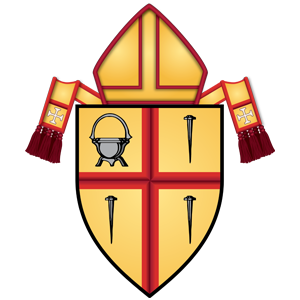
Established: July 11,1936
Encompassing: Imperial and San Diego Counties
Square Miles: 8,852
Total Population: 3,465,920
Catholic Population: 1,386,368
Parishes: 96
Missions: 14
Preschools: 33
Elementary Schools: 42
High Schools: 7
Higher Education: 3
Priests of the Diocese of San Diego
Active: 104
Retired: 47
Priests from other Dioceses:
Active: 26
Retired: 13
Religious Order Priests:
Active: 74
Retired: 19
Permanent Deacons of the Diocese of San Diego
Active in the Diocese: 116
Active outside the Diocese: 12
Retired: 29
Permanent Deacons from other Dioceses
Active in the Diocese: 6
Religious Order Permanent Deacons:
Retired: 1
Religious Sisters: 163
Religious Brothers: 29
Diocesan Coat of Arms

The diocesan coat of arms uses symbols which describe San Diego (in Latin, St. Didacus), the diocesan patron saint.
Diego was born to poor Spanish parents shortly before the year 1400. His love for poverty never left him. As a Franciscan brother, he was a selfless servant of the poor and was known to heal the sick with the Sign of the Cross, the centerpiece of the diocesan coat of arms.
The Spanish stew pot in the upper left corner indicates Diego’s boundless charity and tireless efforts to feed the hungry.
San Diego had a special devotion to the Lord in his Passion, symbolized by the three nails in the other corners of the crest.
Diego died on Nov. 12, 1463, at the Franciscan monastery in Alcalá, Spain, pressing a crucifix to his heart and repeating the words of the Good Friday chant: “Dulce lignum, dulce ferrum, dulce pondus sustinet.” (Precious the wood, precious the nails, precious the weight they bear.)

